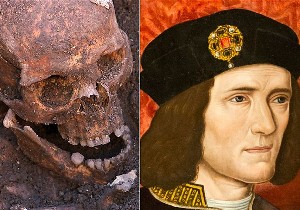Two blows to head caused King Richard III's death on battlefield
 Washington, Sept 17 - Scientists after analyzing the skeleton of King Richard III have found that it was blows to his head at the Battle of Bosworth Field on Aug 22, 1485 that caused his death.
Washington, Sept 17 - Scientists after analyzing the skeleton of King Richard III have found that it was blows to his head at the Battle of Bosworth Field on Aug 22, 1485 that caused his death.
The research led by the University of Leicester in the UK gave a blow-by-blow account of the injuries inflicted on the King's body, and reveal that three of his injuries had the potential to cause death quickly, two to the skull and one to the pelvis.
The remains of King Richard III, the last English monarch to die in battle, were found under a car park in Leicester by archaeologists from the University of Leicester, and subsequently identified by a multidisciplinary team from the University.
The forensic imaging team used whole body CT scans and micro-CT imaging of injured bones to analyse trauma to the 500-year-old skeleton carefully, and to determine which of the King's wounds might have proved fatal. They also analysed tool marks on bone to identify the medieval weapons potentially responsible for his injuries.
The results showed that Richard's skeleton sustained 11 wounds at or near the time of his death, nine of them to the skull, clearly inflicted in battle and suggesting he had removed or lost his helmet, and two to the postcranial skeleton.
Sarah Hainsworth, study author and Professor of Materials Engineering at the University of Leicester explained that Richard's injuries represented a sustained attack or an attack by several assailants with weapons from the later medieval period. The wounds to the skull suggested that he was not wearing a helmet, and the absence of defensive wounds on his arms and hands indicated that he was otherwise still armoured at the time of his death.
According to Professor Guy Rutty, study co-author, from the East Midlands Pathology Unit at the University of Leicester , the most likely injuries to have caused the King's death were the two to the inferior aspect of the skull, a large sharp force trauma possibly from a sword or staff weapon, such as a halberd or bill, and a penetrating injury from the tip of an edged weapon. Richard's head injuries were consistent with some near- contemporary accounts of the battle, which suggested that he abandoned his horse after it became stuck in mire and was killed while fighting his enemies.
The findings are published in The Lancet. (ANI)